Learning Styles in Education and Training: A Comprehensive Report
VerifiedAdded on 2023/01/05
|19
|6448
|30
Report
AI Summary
This report delves into the realm of learning styles, exploring diverse theories, principles, and models applicable to education and training. It analyzes various learning theories, including procedural vs. declarative learning, the Emergentist model, and Vygotsky's philosophy. The report examines how these theories can be applied to teaching, learning, and assessment, considering inductive vs. deductive approaches, personality theories, and the VAK/Fleming model. Furthermore, it analyses models of learning preferences, such as the Honey and Mumford model, and explains how identifying and accommodating individual learning preferences enables inclusive teaching, learning, and assessment. The report also touches upon theories and models of communication, curriculum development, assessment, reflection, and evaluation, offering insights into their application in reviewing educational practices. The report also covers curriculum development, economic ideology, apprenticeship, and blended learning approaches. It emphasizes the importance of adapting teaching methods to suit diverse learning styles, promoting student-centered learning, and fostering a comprehensive understanding of educational practices.
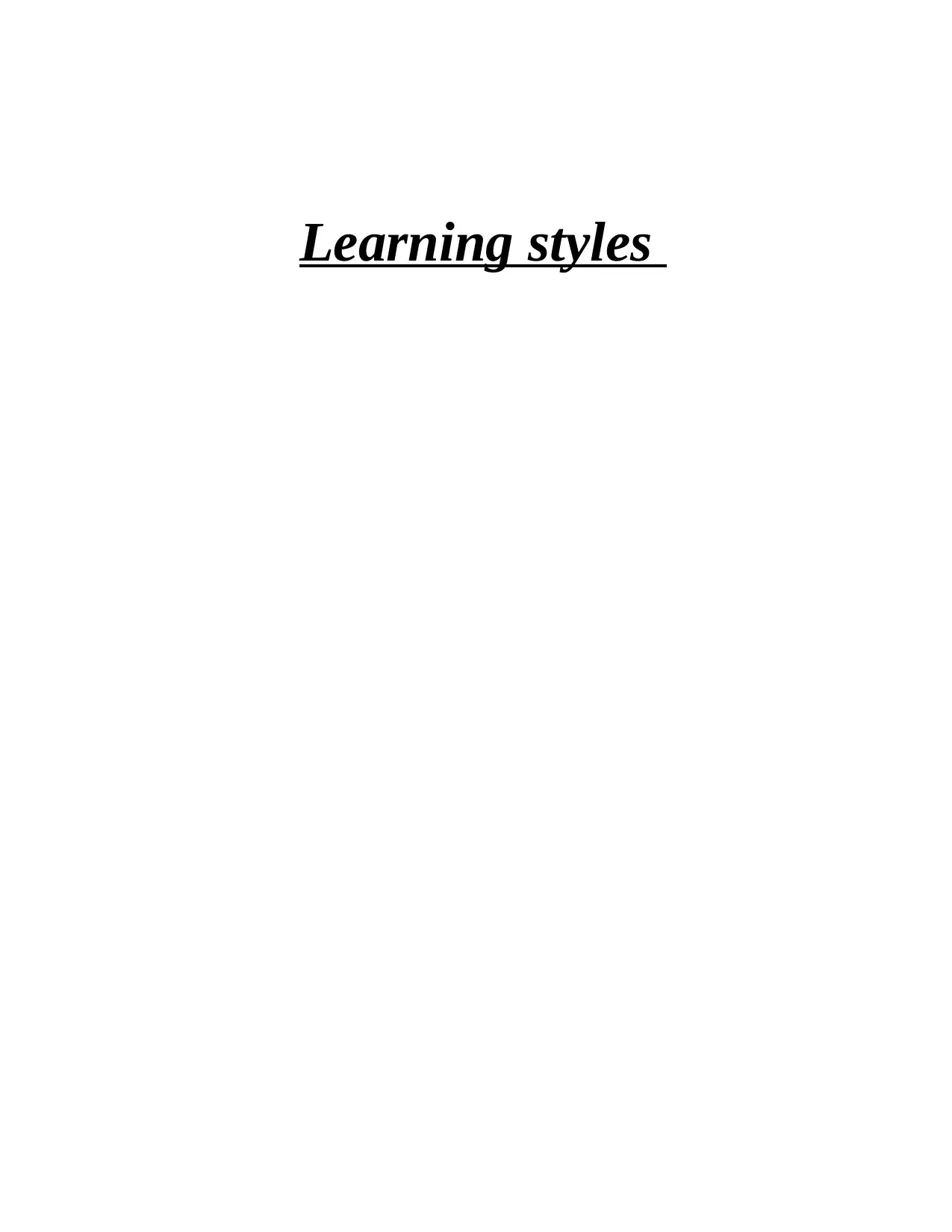
Learning styles
Paraphrase This Document
Need a fresh take? Get an instant paraphrase of this document with our AI Paraphraser
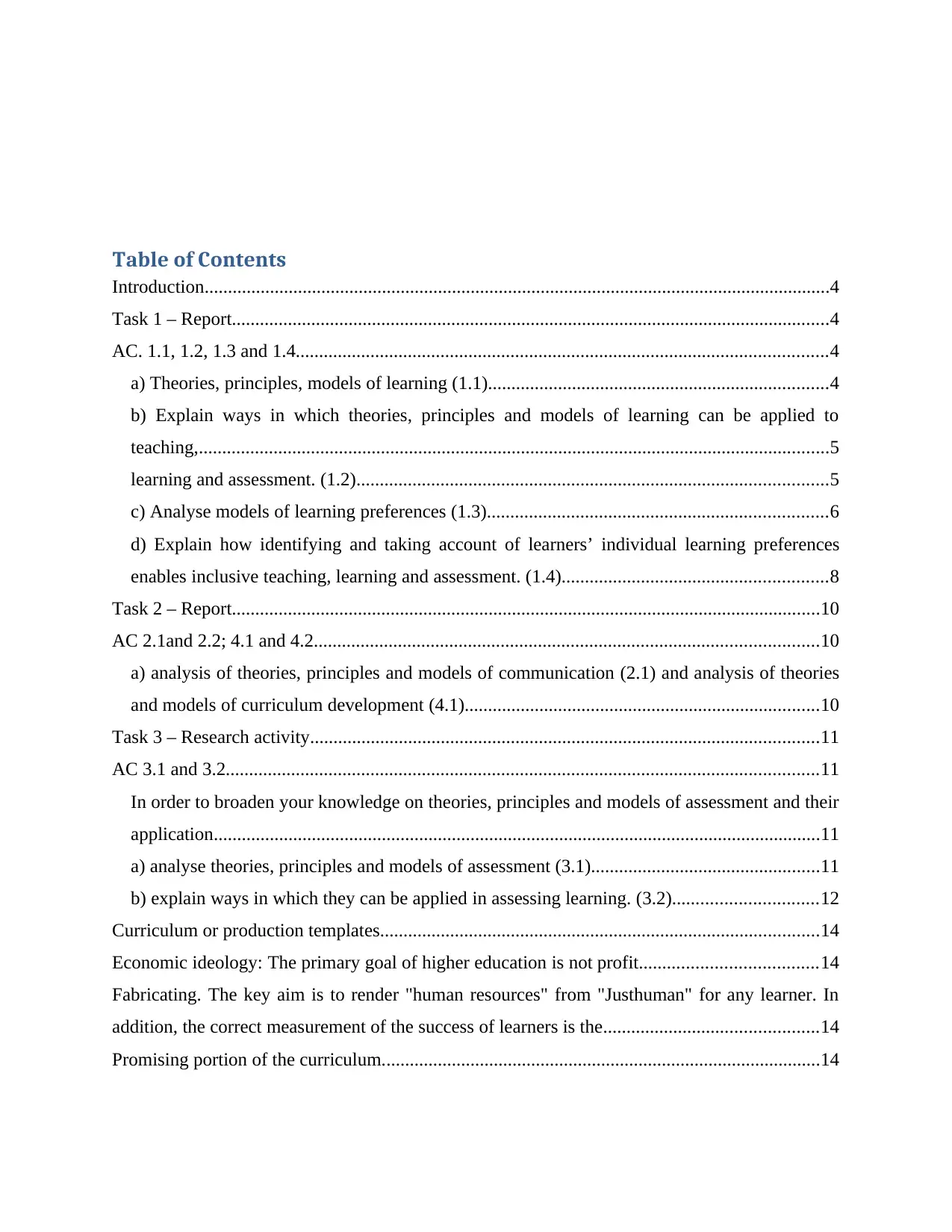
Table of Contents
Introduction......................................................................................................................................4
Task 1 – Report................................................................................................................................4
AC. 1.1, 1.2, 1.3 and 1.4..................................................................................................................4
a) Theories, principles, models of learning (1.1).........................................................................4
b) Explain ways in which theories, principles and models of learning can be applied to
teaching,.......................................................................................................................................5
learning and assessment. (1.2).....................................................................................................5
c) Analyse models of learning preferences (1.3).........................................................................6
d) Explain how identifying and taking account of learners’ individual learning preferences
enables inclusive teaching, learning and assessment. (1.4).........................................................8
Task 2 – Report..............................................................................................................................10
AC 2.1and 2.2; 4.1 and 4.2............................................................................................................10
a) analysis of theories, principles and models of communication (2.1) and analysis of theories
and models of curriculum development (4.1)............................................................................10
Task 3 – Research activity.............................................................................................................11
AC 3.1 and 3.2...............................................................................................................................11
In order to broaden your knowledge on theories, principles and models of assessment and their
application..................................................................................................................................11
a) analyse theories, principles and models of assessment (3.1).................................................11
b) explain ways in which they can be applied in assessing learning. (3.2)...............................12
Curriculum or production templates..............................................................................................14
Economic ideology: The primary goal of higher education is not profit......................................14
Fabricating. The key aim is to render "human resources" from "Justhuman" for any learner. In
addition, the correct measurement of the success of learners is the..............................................14
Promising portion of the curriculum..............................................................................................14
Introduction......................................................................................................................................4
Task 1 – Report................................................................................................................................4
AC. 1.1, 1.2, 1.3 and 1.4..................................................................................................................4
a) Theories, principles, models of learning (1.1).........................................................................4
b) Explain ways in which theories, principles and models of learning can be applied to
teaching,.......................................................................................................................................5
learning and assessment. (1.2).....................................................................................................5
c) Analyse models of learning preferences (1.3).........................................................................6
d) Explain how identifying and taking account of learners’ individual learning preferences
enables inclusive teaching, learning and assessment. (1.4).........................................................8
Task 2 – Report..............................................................................................................................10
AC 2.1and 2.2; 4.1 and 4.2............................................................................................................10
a) analysis of theories, principles and models of communication (2.1) and analysis of theories
and models of curriculum development (4.1)............................................................................10
Task 3 – Research activity.............................................................................................................11
AC 3.1 and 3.2...............................................................................................................................11
In order to broaden your knowledge on theories, principles and models of assessment and their
application..................................................................................................................................11
a) analyse theories, principles and models of assessment (3.1).................................................11
b) explain ways in which they can be applied in assessing learning. (3.2)...............................12
Curriculum or production templates..............................................................................................14
Economic ideology: The primary goal of higher education is not profit......................................14
Fabricating. The key aim is to render "human resources" from "Justhuman" for any learner. In
addition, the correct measurement of the success of learners is the..............................................14
Promising portion of the curriculum..............................................................................................14
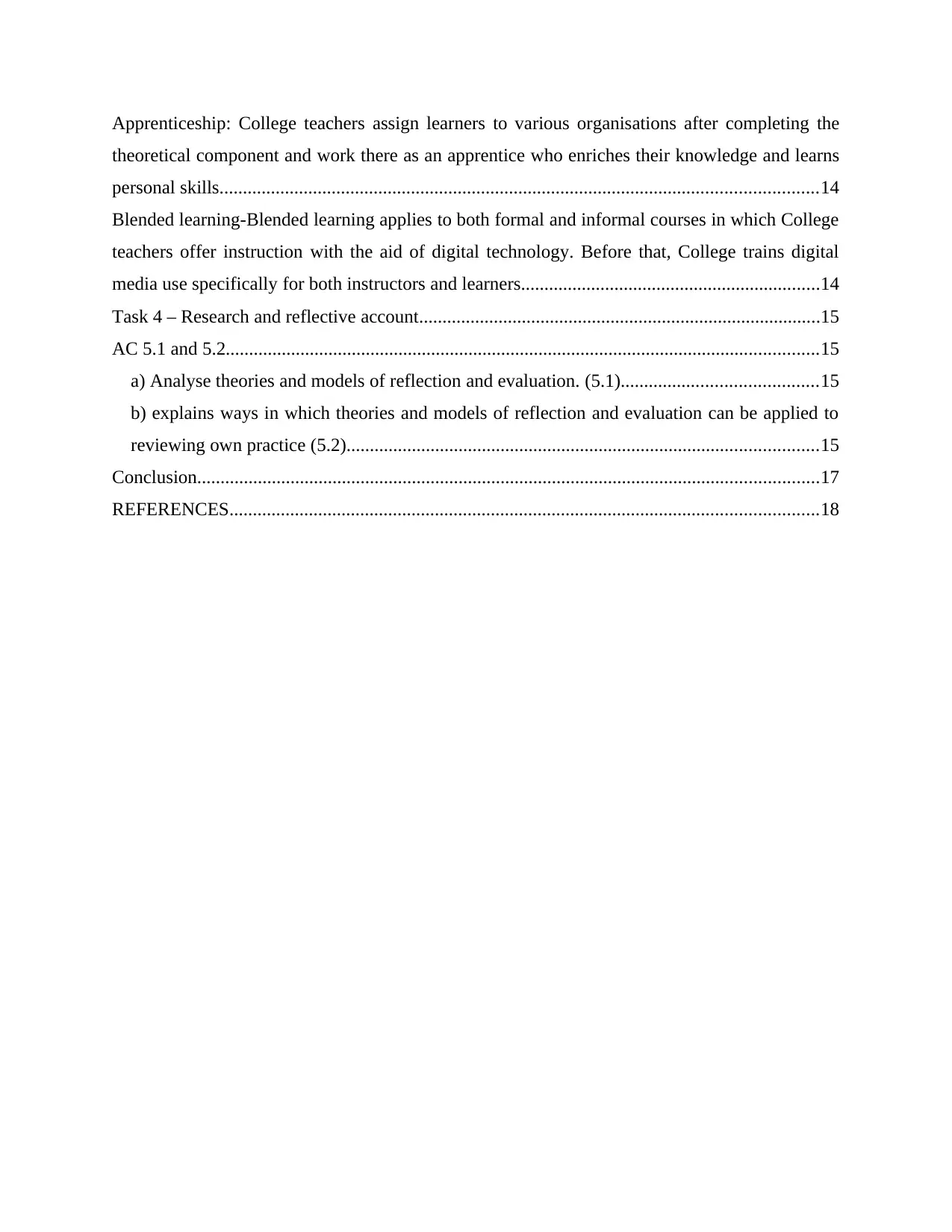
Apprenticeship: College teachers assign learners to various organisations after completing the
theoretical component and work there as an apprentice who enriches their knowledge and learns
personal skills................................................................................................................................14
Blended learning-Blended learning applies to both formal and informal courses in which College
teachers offer instruction with the aid of digital technology. Before that, College trains digital
media use specifically for both instructors and learners................................................................14
Task 4 – Research and reflective account......................................................................................15
AC 5.1 and 5.2...............................................................................................................................15
a) Analyse theories and models of reflection and evaluation. (5.1)..........................................15
b) explains ways in which theories and models of reflection and evaluation can be applied to
reviewing own practice (5.2).....................................................................................................15
Conclusion.....................................................................................................................................17
REFERENCES..............................................................................................................................18
theoretical component and work there as an apprentice who enriches their knowledge and learns
personal skills................................................................................................................................14
Blended learning-Blended learning applies to both formal and informal courses in which College
teachers offer instruction with the aid of digital technology. Before that, College trains digital
media use specifically for both instructors and learners................................................................14
Task 4 – Research and reflective account......................................................................................15
AC 5.1 and 5.2...............................................................................................................................15
a) Analyse theories and models of reflection and evaluation. (5.1)..........................................15
b) explains ways in which theories and models of reflection and evaluation can be applied to
reviewing own practice (5.2).....................................................................................................15
Conclusion.....................................................................................................................................17
REFERENCES..............................................................................................................................18
⊘ This is a preview!⊘
Do you want full access?
Subscribe today to unlock all pages.

Trusted by 1+ million students worldwide
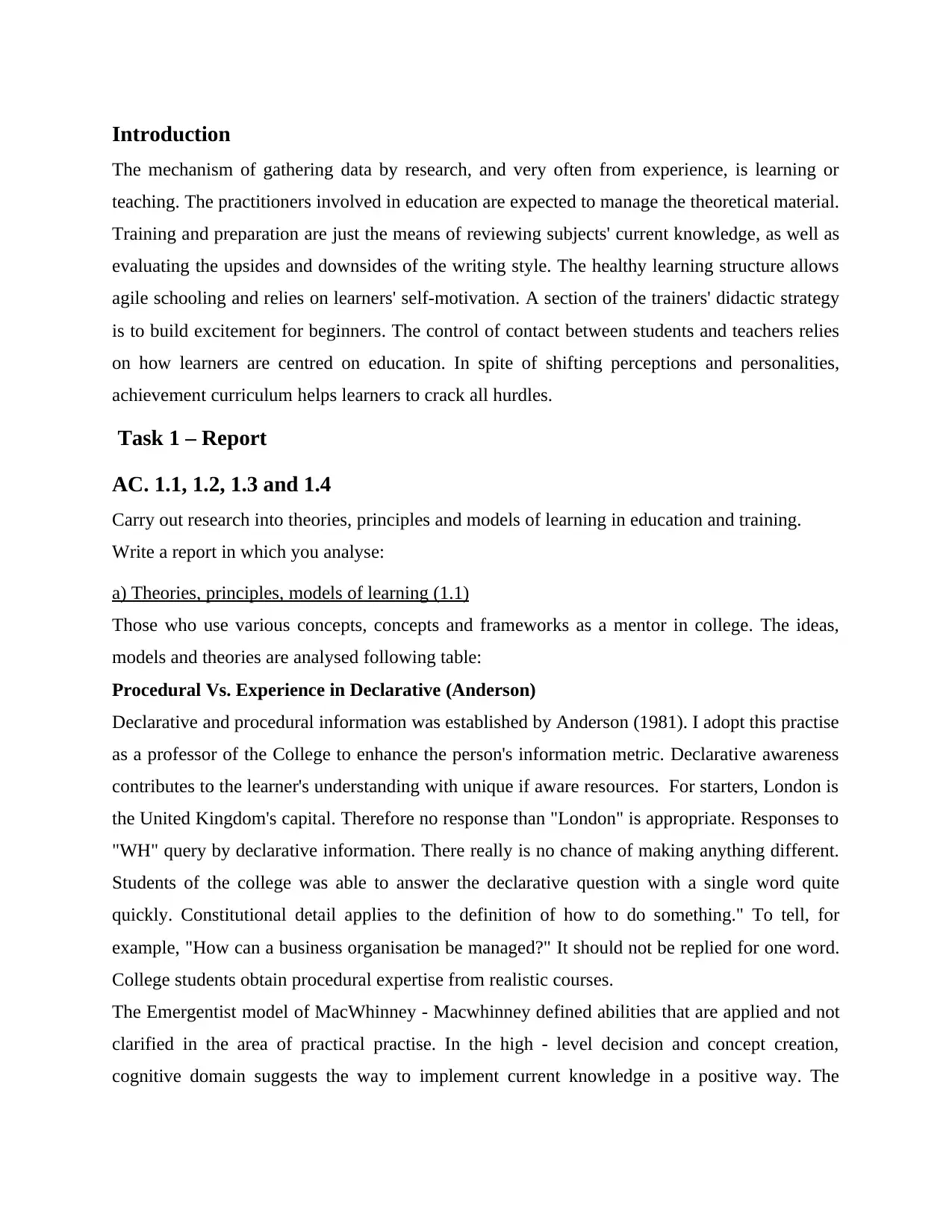
Introduction
The mechanism of gathering data by research, and very often from experience, is learning or
teaching. The practitioners involved in education are expected to manage the theoretical material.
Training and preparation are just the means of reviewing subjects' current knowledge, as well as
evaluating the upsides and downsides of the writing style. The healthy learning structure allows
agile schooling and relies on learners' self-motivation. A section of the trainers' didactic strategy
is to build excitement for beginners. The control of contact between students and teachers relies
on how learners are centred on education. In spite of shifting perceptions and personalities,
achievement curriculum helps learners to crack all hurdles.
Task 1 – Report
AC. 1.1, 1.2, 1.3 and 1.4
Carry out research into theories, principles and models of learning in education and training.
Write a report in which you analyse:
a) Theories, principles, models of learning (1.1)
Those who use various concepts, concepts and frameworks as a mentor in college. The ideas,
models and theories are analysed following table:
Procedural Vs. Experience in Declarative (Anderson)
Declarative and procedural information was established by Anderson (1981). I adopt this practise
as a professor of the College to enhance the person's information metric. Declarative awareness
contributes to the learner's understanding with unique if aware resources. For starters, London is
the United Kingdom's capital. Therefore no response than "London" is appropriate. Responses to
"WH" query by declarative information. There really is no chance of making anything different.
Students of the college was able to answer the declarative question with a single word quite
quickly. Constitutional detail applies to the definition of how to do something." To tell, for
example, "How can a business organisation be managed?" It should not be replied for one word.
College students obtain procedural expertise from realistic courses.
The Emergentist model of MacWhinney - Macwhinney defined abilities that are applied and not
clarified in the area of practical practise. In the high - level decision and concept creation,
cognitive domain suggests the way to implement current knowledge in a positive way. The
The mechanism of gathering data by research, and very often from experience, is learning or
teaching. The practitioners involved in education are expected to manage the theoretical material.
Training and preparation are just the means of reviewing subjects' current knowledge, as well as
evaluating the upsides and downsides of the writing style. The healthy learning structure allows
agile schooling and relies on learners' self-motivation. A section of the trainers' didactic strategy
is to build excitement for beginners. The control of contact between students and teachers relies
on how learners are centred on education. In spite of shifting perceptions and personalities,
achievement curriculum helps learners to crack all hurdles.
Task 1 – Report
AC. 1.1, 1.2, 1.3 and 1.4
Carry out research into theories, principles and models of learning in education and training.
Write a report in which you analyse:
a) Theories, principles, models of learning (1.1)
Those who use various concepts, concepts and frameworks as a mentor in college. The ideas,
models and theories are analysed following table:
Procedural Vs. Experience in Declarative (Anderson)
Declarative and procedural information was established by Anderson (1981). I adopt this practise
as a professor of the College to enhance the person's information metric. Declarative awareness
contributes to the learner's understanding with unique if aware resources. For starters, London is
the United Kingdom's capital. Therefore no response than "London" is appropriate. Responses to
"WH" query by declarative information. There really is no chance of making anything different.
Students of the college was able to answer the declarative question with a single word quite
quickly. Constitutional detail applies to the definition of how to do something." To tell, for
example, "How can a business organisation be managed?" It should not be replied for one word.
College students obtain procedural expertise from realistic courses.
The Emergentist model of MacWhinney - Macwhinney defined abilities that are applied and not
clarified in the area of practical practise. In the high - level decision and concept creation,
cognitive domain suggests the way to implement current knowledge in a positive way. The
Paraphrase This Document
Need a fresh take? Get an instant paraphrase of this document with our AI Paraphraser
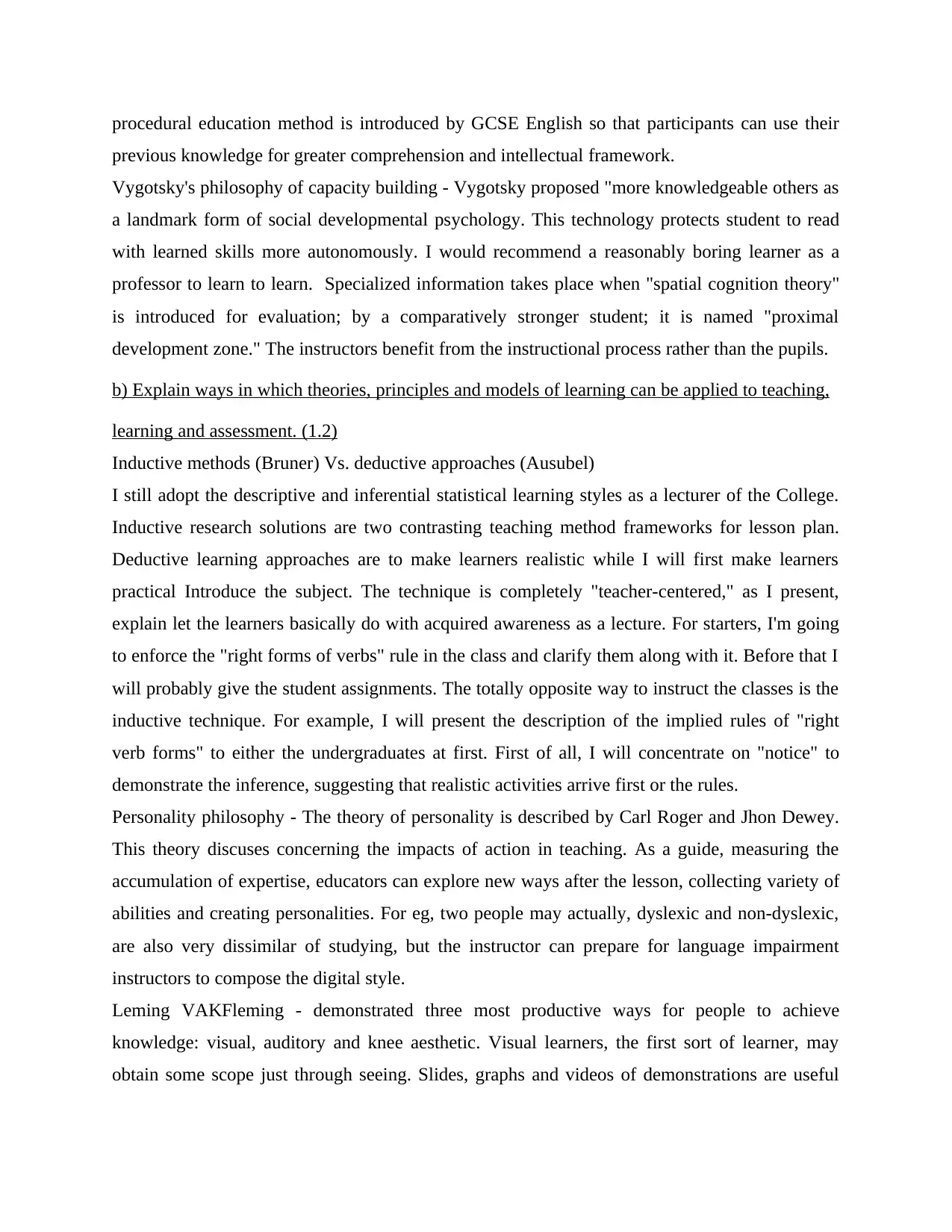
procedural education method is introduced by GCSE English so that participants can use their
previous knowledge for greater comprehension and intellectual framework.
Vygotsky's philosophy of capacity building - Vygotsky proposed "more knowledgeable others as
a landmark form of social developmental psychology. This technology protects student to read
with learned skills more autonomously. I would recommend a reasonably boring learner as a
professor to learn to learn. Specialized information takes place when "spatial cognition theory"
is introduced for evaluation; by a comparatively stronger student; it is named "proximal
development zone." The instructors benefit from the instructional process rather than the pupils.
b) Explain ways in which theories, principles and models of learning can be applied to teaching,
learning and assessment. (1.2)
Inductive methods (Bruner) Vs. deductive approaches (Ausubel)
I still adopt the descriptive and inferential statistical learning styles as a lecturer of the College.
Inductive research solutions are two contrasting teaching method frameworks for lesson plan.
Deductive learning approaches are to make learners realistic while I will first make learners
practical Introduce the subject. The technique is completely "teacher-centered," as I present,
explain let the learners basically do with acquired awareness as a lecture. For starters, I'm going
to enforce the "right forms of verbs" rule in the class and clarify them along with it. Before that I
will probably give the student assignments. The totally opposite way to instruct the classes is the
inductive technique. For example, I will present the description of the implied rules of "right
verb forms" to either the undergraduates at first. First of all, I will concentrate on "notice" to
demonstrate the inference, suggesting that realistic activities arrive first or the rules.
Personality philosophy - The theory of personality is described by Carl Roger and Jhon Dewey.
This theory discuses concerning the impacts of action in teaching. As a guide, measuring the
accumulation of expertise, educators can explore new ways after the lesson, collecting variety of
abilities and creating personalities. For eg, two people may actually, dyslexic and non-dyslexic,
are also very dissimilar of studying, but the instructor can prepare for language impairment
instructors to compose the digital style.
Leming VAKFleming - demonstrated three most productive ways for people to achieve
knowledge: visual, auditory and knee aesthetic. Visual learners, the first sort of learner, may
obtain some scope just through seeing. Slides, graphs and videos of demonstrations are useful
previous knowledge for greater comprehension and intellectual framework.
Vygotsky's philosophy of capacity building - Vygotsky proposed "more knowledgeable others as
a landmark form of social developmental psychology. This technology protects student to read
with learned skills more autonomously. I would recommend a reasonably boring learner as a
professor to learn to learn. Specialized information takes place when "spatial cognition theory"
is introduced for evaluation; by a comparatively stronger student; it is named "proximal
development zone." The instructors benefit from the instructional process rather than the pupils.
b) Explain ways in which theories, principles and models of learning can be applied to teaching,
learning and assessment. (1.2)
Inductive methods (Bruner) Vs. deductive approaches (Ausubel)
I still adopt the descriptive and inferential statistical learning styles as a lecturer of the College.
Inductive research solutions are two contrasting teaching method frameworks for lesson plan.
Deductive learning approaches are to make learners realistic while I will first make learners
practical Introduce the subject. The technique is completely "teacher-centered," as I present,
explain let the learners basically do with acquired awareness as a lecture. For starters, I'm going
to enforce the "right forms of verbs" rule in the class and clarify them along with it. Before that I
will probably give the student assignments. The totally opposite way to instruct the classes is the
inductive technique. For example, I will present the description of the implied rules of "right
verb forms" to either the undergraduates at first. First of all, I will concentrate on "notice" to
demonstrate the inference, suggesting that realistic activities arrive first or the rules.
Personality philosophy - The theory of personality is described by Carl Roger and Jhon Dewey.
This theory discuses concerning the impacts of action in teaching. As a guide, measuring the
accumulation of expertise, educators can explore new ways after the lesson, collecting variety of
abilities and creating personalities. For eg, two people may actually, dyslexic and non-dyslexic,
are also very dissimilar of studying, but the instructor can prepare for language impairment
instructors to compose the digital style.
Leming VAKFleming - demonstrated three most productive ways for people to achieve
knowledge: visual, auditory and knee aesthetic. Visual learners, the first sort of learner, may
obtain some scope just through seeing. Slides, graphs and videos of demonstrations are useful
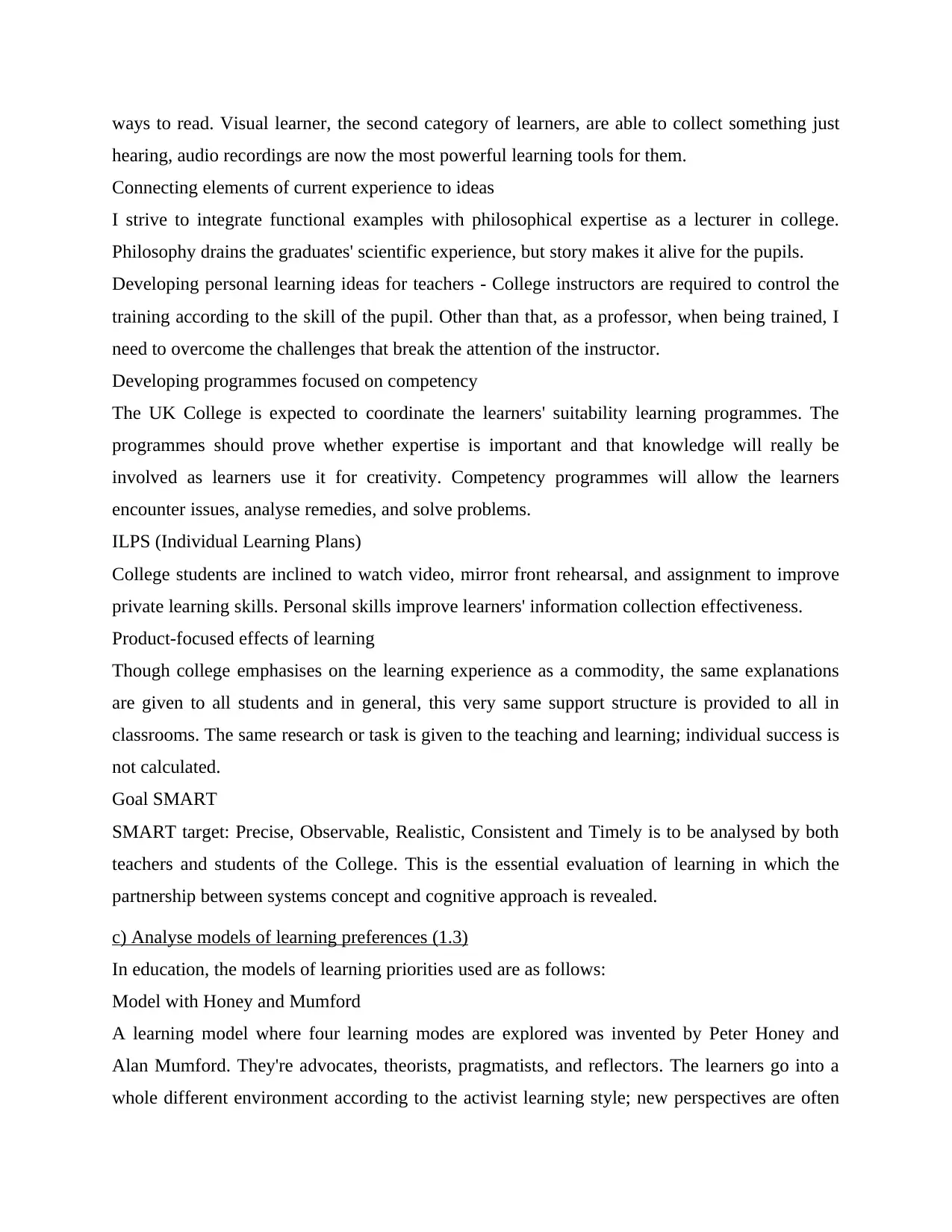
ways to read. Visual learner, the second category of learners, are able to collect something just
hearing, audio recordings are now the most powerful learning tools for them.
Connecting elements of current experience to ideas
I strive to integrate functional examples with philosophical expertise as a lecturer in college.
Philosophy drains the graduates' scientific experience, but story makes it alive for the pupils.
Developing personal learning ideas for teachers - College instructors are required to control the
training according to the skill of the pupil. Other than that, as a professor, when being trained, I
need to overcome the challenges that break the attention of the instructor.
Developing programmes focused on competency
The UK College is expected to coordinate the learners' suitability learning programmes. The
programmes should prove whether expertise is important and that knowledge will really be
involved as learners use it for creativity. Competency programmes will allow the learners
encounter issues, analyse remedies, and solve problems.
ILPS (Individual Learning Plans)
College students are inclined to watch video, mirror front rehearsal, and assignment to improve
private learning skills. Personal skills improve learners' information collection effectiveness.
Product-focused effects of learning
Though college emphasises on the learning experience as a commodity, the same explanations
are given to all students and in general, this very same support structure is provided to all in
classrooms. The same research or task is given to the teaching and learning; individual success is
not calculated.
Goal SMART
SMART target: Precise, Observable, Realistic, Consistent and Timely is to be analysed by both
teachers and students of the College. This is the essential evaluation of learning in which the
partnership between systems concept and cognitive approach is revealed.
c) Analyse models of learning preferences (1.3)
In education, the models of learning priorities used are as follows:
Model with Honey and Mumford
A learning model where four learning modes are explored was invented by Peter Honey and
Alan Mumford. They're advocates, theorists, pragmatists, and reflectors. The learners go into a
whole different environment according to the activist learning style; new perspectives are often
hearing, audio recordings are now the most powerful learning tools for them.
Connecting elements of current experience to ideas
I strive to integrate functional examples with philosophical expertise as a lecturer in college.
Philosophy drains the graduates' scientific experience, but story makes it alive for the pupils.
Developing personal learning ideas for teachers - College instructors are required to control the
training according to the skill of the pupil. Other than that, as a professor, when being trained, I
need to overcome the challenges that break the attention of the instructor.
Developing programmes focused on competency
The UK College is expected to coordinate the learners' suitability learning programmes. The
programmes should prove whether expertise is important and that knowledge will really be
involved as learners use it for creativity. Competency programmes will allow the learners
encounter issues, analyse remedies, and solve problems.
ILPS (Individual Learning Plans)
College students are inclined to watch video, mirror front rehearsal, and assignment to improve
private learning skills. Personal skills improve learners' information collection effectiveness.
Product-focused effects of learning
Though college emphasises on the learning experience as a commodity, the same explanations
are given to all students and in general, this very same support structure is provided to all in
classrooms. The same research or task is given to the teaching and learning; individual success is
not calculated.
Goal SMART
SMART target: Precise, Observable, Realistic, Consistent and Timely is to be analysed by both
teachers and students of the College. This is the essential evaluation of learning in which the
partnership between systems concept and cognitive approach is revealed.
c) Analyse models of learning preferences (1.3)
In education, the models of learning priorities used are as follows:
Model with Honey and Mumford
A learning model where four learning modes are explored was invented by Peter Honey and
Alan Mumford. They're advocates, theorists, pragmatists, and reflectors. The learners go into a
whole different environment according to the activist learning style; new perspectives are often
⊘ This is a preview!⊘
Do you want full access?
Subscribe today to unlock all pages.

Trusted by 1+ million students worldwide
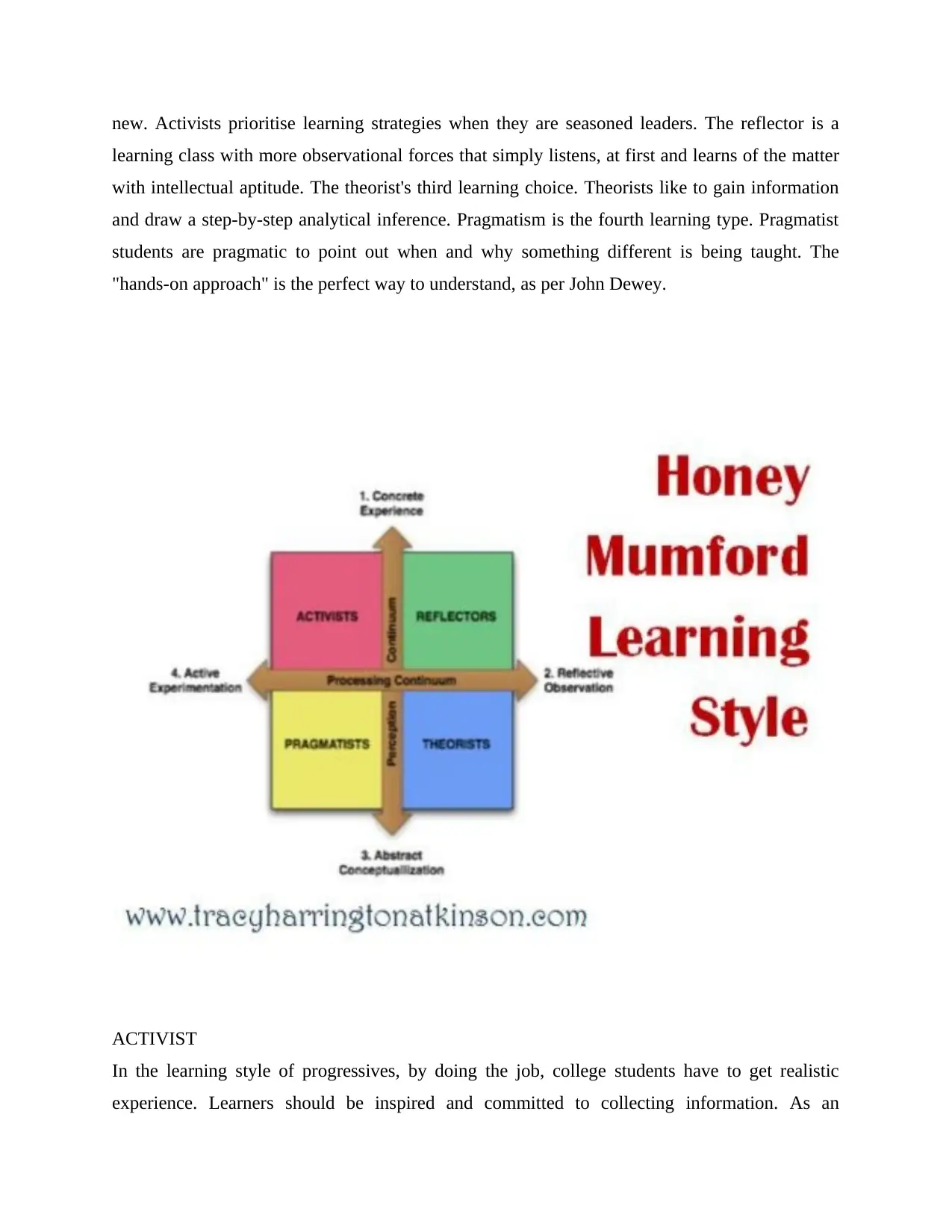
new. Activists prioritise learning strategies when they are seasoned leaders. The reflector is a
learning class with more observational forces that simply listens, at first and learns of the matter
with intellectual aptitude. The theorist's third learning choice. Theorists like to gain information
and draw a step-by-step analytical inference. Pragmatism is the fourth learning type. Pragmatist
students are pragmatic to point out when and why something different is being taught. The
"hands-on approach" is the perfect way to understand, as per John Dewey.
ACTIVIST
In the learning style of progressives, by doing the job, college students have to get realistic
experience. Learners should be inspired and committed to collecting information. As an
learning class with more observational forces that simply listens, at first and learns of the matter
with intellectual aptitude. The theorist's third learning choice. Theorists like to gain information
and draw a step-by-step analytical inference. Pragmatism is the fourth learning type. Pragmatist
students are pragmatic to point out when and why something different is being taught. The
"hands-on approach" is the perfect way to understand, as per John Dewey.
ACTIVIST
In the learning style of progressives, by doing the job, college students have to get realistic
experience. Learners should be inspired and committed to collecting information. As an
Paraphrase This Document
Need a fresh take? Get an instant paraphrase of this document with our AI Paraphraser
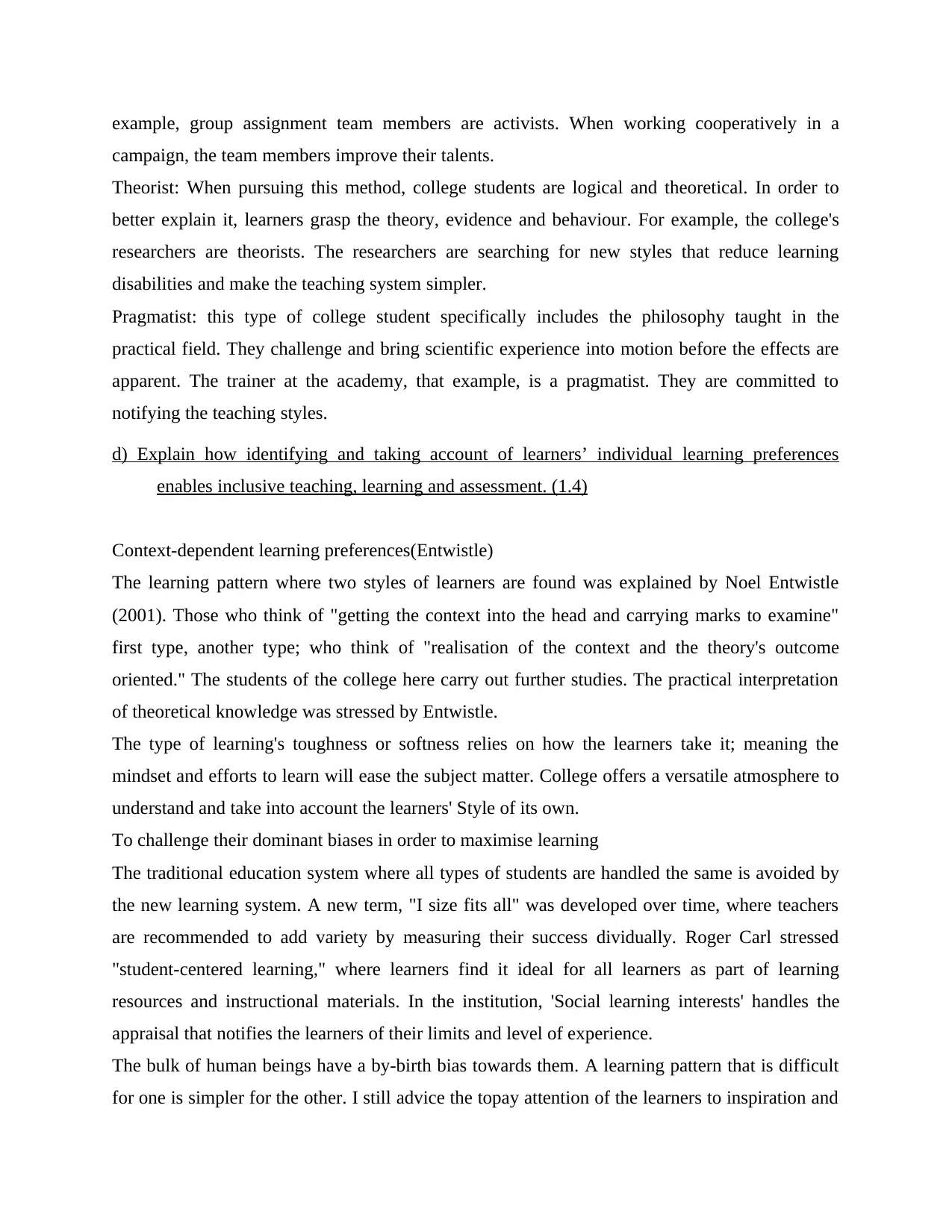
example, group assignment team members are activists. When working cooperatively in a
campaign, the team members improve their talents.
Theorist: When pursuing this method, college students are logical and theoretical. In order to
better explain it, learners grasp the theory, evidence and behaviour. For example, the college's
researchers are theorists. The researchers are searching for new styles that reduce learning
disabilities and make the teaching system simpler.
Pragmatist: this type of college student specifically includes the philosophy taught in the
practical field. They challenge and bring scientific experience into motion before the effects are
apparent. The trainer at the academy, that example, is a pragmatist. They are committed to
notifying the teaching styles.
d) Explain how identifying and taking account of learners’ individual learning preferences
enables inclusive teaching, learning and assessment. (1.4)
Context-dependent learning preferences(Entwistle)
The learning pattern where two styles of learners are found was explained by Noel Entwistle
(2001). Those who think of "getting the context into the head and carrying marks to examine"
first type, another type; who think of "realisation of the context and the theory's outcome
oriented." The students of the college here carry out further studies. The practical interpretation
of theoretical knowledge was stressed by Entwistle.
The type of learning's toughness or softness relies on how the learners take it; meaning the
mindset and efforts to learn will ease the subject matter. College offers a versatile atmosphere to
understand and take into account the learners' Style of its own.
To challenge their dominant biases in order to maximise learning
The traditional education system where all types of students are handled the same is avoided by
the new learning system. A new term, "I size fits all" was developed over time, where teachers
are recommended to add variety by measuring their success dividually. Roger Carl stressed
"student-centered learning," where learners find it ideal for all learners as part of learning
resources and instructional materials. In the institution, 'Social learning interests' handles the
appraisal that notifies the learners of their limits and level of experience.
The bulk of human beings have a by-birth bias towards them. A learning pattern that is difficult
for one is simpler for the other. I still advice the topay attention of the learners to inspiration and
campaign, the team members improve their talents.
Theorist: When pursuing this method, college students are logical and theoretical. In order to
better explain it, learners grasp the theory, evidence and behaviour. For example, the college's
researchers are theorists. The researchers are searching for new styles that reduce learning
disabilities and make the teaching system simpler.
Pragmatist: this type of college student specifically includes the philosophy taught in the
practical field. They challenge and bring scientific experience into motion before the effects are
apparent. The trainer at the academy, that example, is a pragmatist. They are committed to
notifying the teaching styles.
d) Explain how identifying and taking account of learners’ individual learning preferences
enables inclusive teaching, learning and assessment. (1.4)
Context-dependent learning preferences(Entwistle)
The learning pattern where two styles of learners are found was explained by Noel Entwistle
(2001). Those who think of "getting the context into the head and carrying marks to examine"
first type, another type; who think of "realisation of the context and the theory's outcome
oriented." The students of the college here carry out further studies. The practical interpretation
of theoretical knowledge was stressed by Entwistle.
The type of learning's toughness or softness relies on how the learners take it; meaning the
mindset and efforts to learn will ease the subject matter. College offers a versatile atmosphere to
understand and take into account the learners' Style of its own.
To challenge their dominant biases in order to maximise learning
The traditional education system where all types of students are handled the same is avoided by
the new learning system. A new term, "I size fits all" was developed over time, where teachers
are recommended to add variety by measuring their success dividually. Roger Carl stressed
"student-centered learning," where learners find it ideal for all learners as part of learning
resources and instructional materials. In the institution, 'Social learning interests' handles the
appraisal that notifies the learners of their limits and level of experience.
The bulk of human beings have a by-birth bias towards them. A learning pattern that is difficult
for one is simpler for the other. I still advice the topay attention of the learners to inspiration and
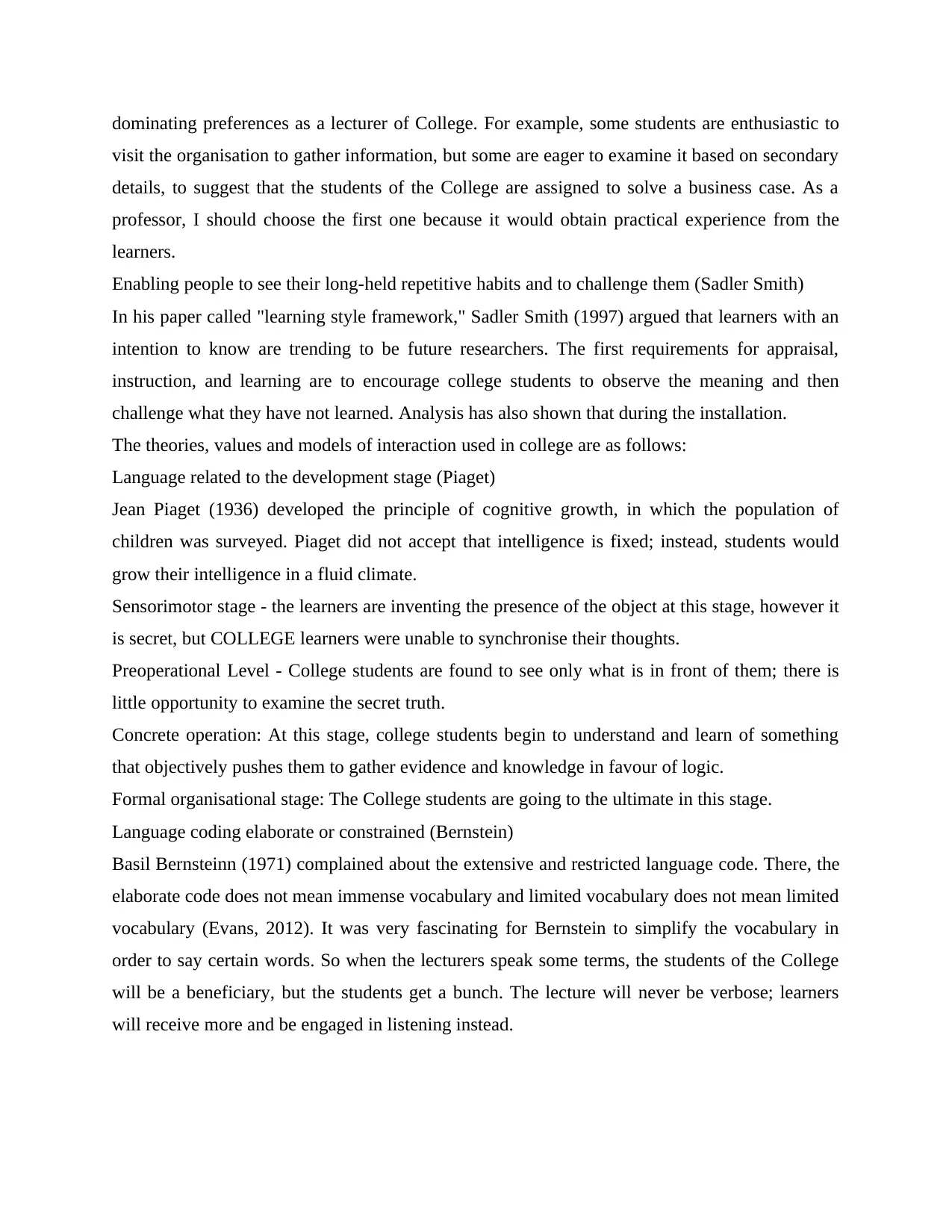
dominating preferences as a lecturer of College. For example, some students are enthusiastic to
visit the organisation to gather information, but some are eager to examine it based on secondary
details, to suggest that the students of the College are assigned to solve a business case. As a
professor, I should choose the first one because it would obtain practical experience from the
learners.
Enabling people to see their long-held repetitive habits and to challenge them (Sadler Smith)
In his paper called "learning style framework," Sadler Smith (1997) argued that learners with an
intention to know are trending to be future researchers. The first requirements for appraisal,
instruction, and learning are to encourage college students to observe the meaning and then
challenge what they have not learned. Analysis has also shown that during the installation.
The theories, values and models of interaction used in college are as follows:
Language related to the development stage (Piaget)
Jean Piaget (1936) developed the principle of cognitive growth, in which the population of
children was surveyed. Piaget did not accept that intelligence is fixed; instead, students would
grow their intelligence in a fluid climate.
Sensorimotor stage - the learners are inventing the presence of the object at this stage, however it
is secret, but COLLEGE learners were unable to synchronise their thoughts.
Preoperational Level - College students are found to see only what is in front of them; there is
little opportunity to examine the secret truth.
Concrete operation: At this stage, college students begin to understand and learn of something
that objectively pushes them to gather evidence and knowledge in favour of logic.
Formal organisational stage: The College students are going to the ultimate in this stage.
Language coding elaborate or constrained (Bernstein)
Basil Bernsteinn (1971) complained about the extensive and restricted language code. There, the
elaborate code does not mean immense vocabulary and limited vocabulary does not mean limited
vocabulary (Evans, 2012). It was very fascinating for Bernstein to simplify the vocabulary in
order to say certain words. So when the lecturers speak some terms, the students of the College
will be a beneficiary, but the students get a bunch. The lecture will never be verbose; learners
will receive more and be engaged in listening instead.
visit the organisation to gather information, but some are eager to examine it based on secondary
details, to suggest that the students of the College are assigned to solve a business case. As a
professor, I should choose the first one because it would obtain practical experience from the
learners.
Enabling people to see their long-held repetitive habits and to challenge them (Sadler Smith)
In his paper called "learning style framework," Sadler Smith (1997) argued that learners with an
intention to know are trending to be future researchers. The first requirements for appraisal,
instruction, and learning are to encourage college students to observe the meaning and then
challenge what they have not learned. Analysis has also shown that during the installation.
The theories, values and models of interaction used in college are as follows:
Language related to the development stage (Piaget)
Jean Piaget (1936) developed the principle of cognitive growth, in which the population of
children was surveyed. Piaget did not accept that intelligence is fixed; instead, students would
grow their intelligence in a fluid climate.
Sensorimotor stage - the learners are inventing the presence of the object at this stage, however it
is secret, but COLLEGE learners were unable to synchronise their thoughts.
Preoperational Level - College students are found to see only what is in front of them; there is
little opportunity to examine the secret truth.
Concrete operation: At this stage, college students begin to understand and learn of something
that objectively pushes them to gather evidence and knowledge in favour of logic.
Formal organisational stage: The College students are going to the ultimate in this stage.
Language coding elaborate or constrained (Bernstein)
Basil Bernsteinn (1971) complained about the extensive and restricted language code. There, the
elaborate code does not mean immense vocabulary and limited vocabulary does not mean limited
vocabulary (Evans, 2012). It was very fascinating for Bernstein to simplify the vocabulary in
order to say certain words. So when the lecturers speak some terms, the students of the College
will be a beneficiary, but the students get a bunch. The lecture will never be verbose; learners
will receive more and be engaged in listening instead.
⊘ This is a preview!⊘
Do you want full access?
Subscribe today to unlock all pages.

Trusted by 1+ million students worldwide
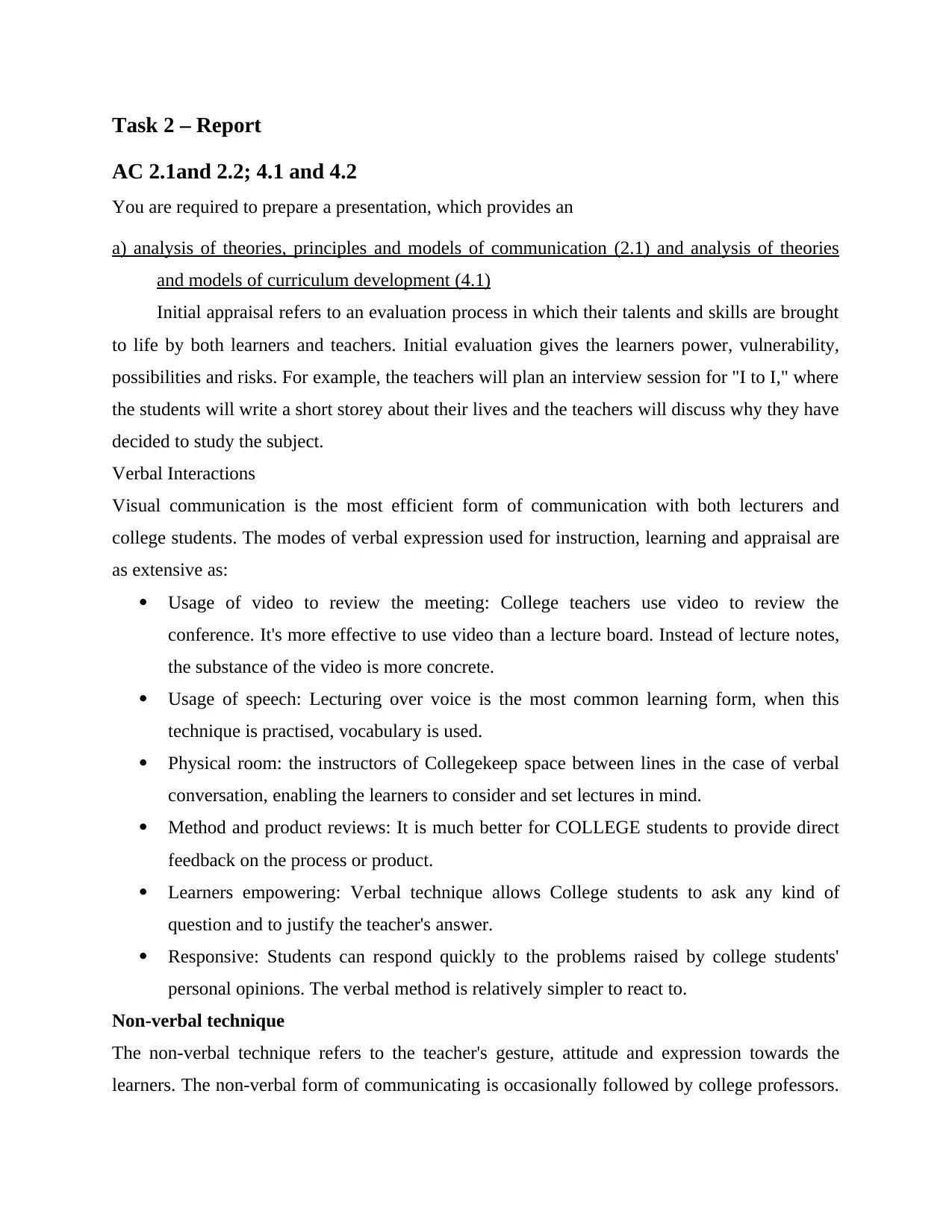
Task 2 – Report
AC 2.1and 2.2; 4.1 and 4.2
You are required to prepare a presentation, which provides an
a) analysis of theories, principles and models of communication (2.1) and analysis of theories
and models of curriculum development (4.1)
Initial appraisal refers to an evaluation process in which their talents and skills are brought
to life by both learners and teachers. Initial evaluation gives the learners power, vulnerability,
possibilities and risks. For example, the teachers will plan an interview session for "I to I," where
the students will write a short storey about their lives and the teachers will discuss why they have
decided to study the subject.
Verbal Interactions
Visual communication is the most efficient form of communication with both lecturers and
college students. The modes of verbal expression used for instruction, learning and appraisal are
as extensive as:
Usage of video to review the meeting: College teachers use video to review the
conference. It's more effective to use video than a lecture board. Instead of lecture notes,
the substance of the video is more concrete.
Usage of speech: Lecturing over voice is the most common learning form, when this
technique is practised, vocabulary is used.
Physical room: the instructors of Collegekeep space between lines in the case of verbal
conversation, enabling the learners to consider and set lectures in mind.
Method and product reviews: It is much better for COLLEGE students to provide direct
feedback on the process or product.
Learners empowering: Verbal technique allows College students to ask any kind of
question and to justify the teacher's answer.
Responsive: Students can respond quickly to the problems raised by college students'
personal opinions. The verbal method is relatively simpler to react to.
Non-verbal technique
The non-verbal technique refers to the teacher's gesture, attitude and expression towards the
learners. The non-verbal form of communicating is occasionally followed by college professors.
AC 2.1and 2.2; 4.1 and 4.2
You are required to prepare a presentation, which provides an
a) analysis of theories, principles and models of communication (2.1) and analysis of theories
and models of curriculum development (4.1)
Initial appraisal refers to an evaluation process in which their talents and skills are brought
to life by both learners and teachers. Initial evaluation gives the learners power, vulnerability,
possibilities and risks. For example, the teachers will plan an interview session for "I to I," where
the students will write a short storey about their lives and the teachers will discuss why they have
decided to study the subject.
Verbal Interactions
Visual communication is the most efficient form of communication with both lecturers and
college students. The modes of verbal expression used for instruction, learning and appraisal are
as extensive as:
Usage of video to review the meeting: College teachers use video to review the
conference. It's more effective to use video than a lecture board. Instead of lecture notes,
the substance of the video is more concrete.
Usage of speech: Lecturing over voice is the most common learning form, when this
technique is practised, vocabulary is used.
Physical room: the instructors of Collegekeep space between lines in the case of verbal
conversation, enabling the learners to consider and set lectures in mind.
Method and product reviews: It is much better for COLLEGE students to provide direct
feedback on the process or product.
Learners empowering: Verbal technique allows College students to ask any kind of
question and to justify the teacher's answer.
Responsive: Students can respond quickly to the problems raised by college students'
personal opinions. The verbal method is relatively simpler to react to.
Non-verbal technique
The non-verbal technique refers to the teacher's gesture, attitude and expression towards the
learners. The non-verbal form of communicating is occasionally followed by college professors.
Paraphrase This Document
Need a fresh take? Get an instant paraphrase of this document with our AI Paraphraser
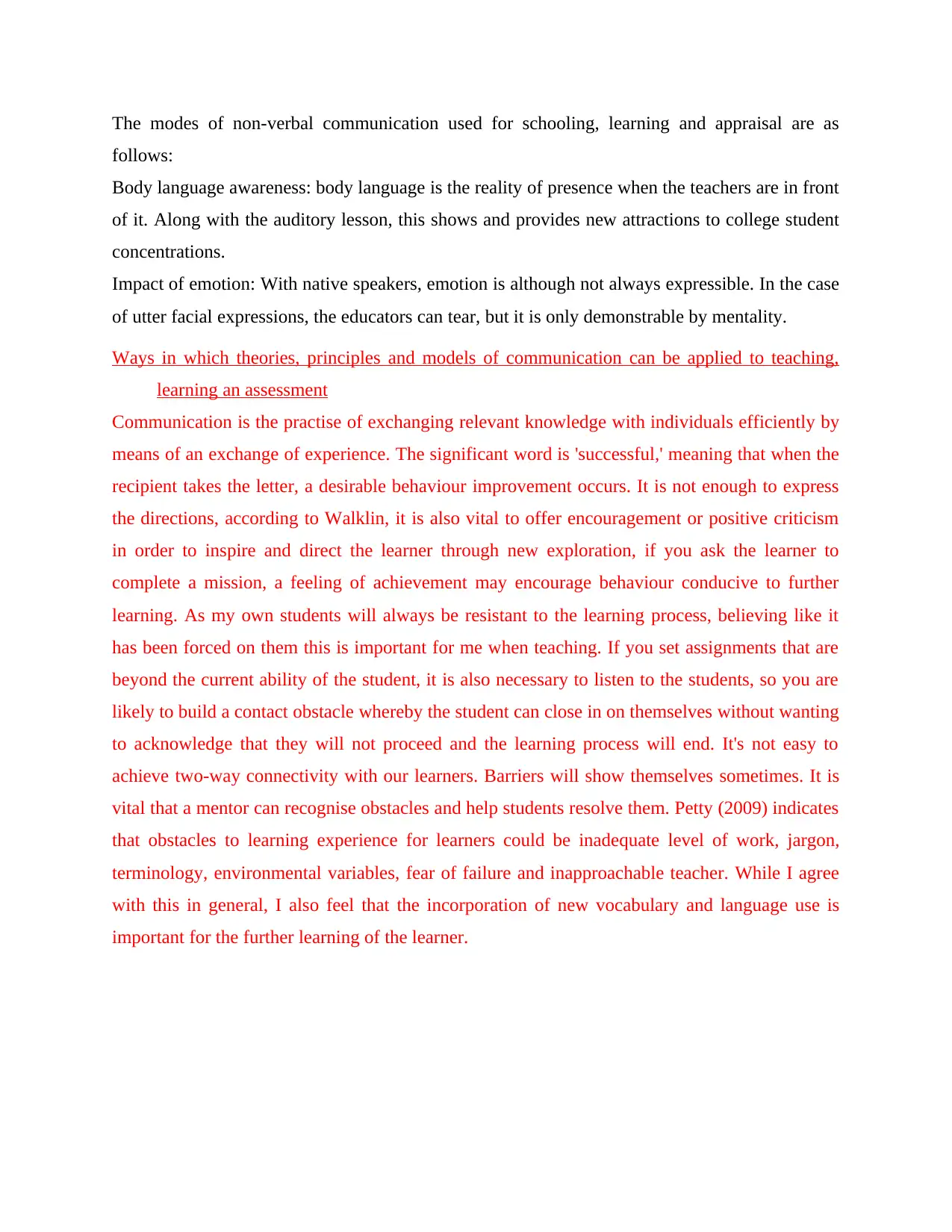
The modes of non-verbal communication used for schooling, learning and appraisal are as
follows:
Body language awareness: body language is the reality of presence when the teachers are in front
of it. Along with the auditory lesson, this shows and provides new attractions to college student
concentrations.
Impact of emotion: With native speakers, emotion is although not always expressible. In the case
of utter facial expressions, the educators can tear, but it is only demonstrable by mentality.
Ways in which theories, principles and models of communication can be applied to teaching,
learning an assessment
Communication is the practise of exchanging relevant knowledge with individuals efficiently by
means of an exchange of experience. The significant word is 'successful,' meaning that when the
recipient takes the letter, a desirable behaviour improvement occurs. It is not enough to express
the directions, according to Walklin, it is also vital to offer encouragement or positive criticism
in order to inspire and direct the learner through new exploration, if you ask the learner to
complete a mission, a feeling of achievement may encourage behaviour conducive to further
learning. As my own students will always be resistant to the learning process, believing like it
has been forced on them this is important for me when teaching. If you set assignments that are
beyond the current ability of the student, it is also necessary to listen to the students, so you are
likely to build a contact obstacle whereby the student can close in on themselves without wanting
to acknowledge that they will not proceed and the learning process will end. It's not easy to
achieve two-way connectivity with our learners. Barriers will show themselves sometimes. It is
vital that a mentor can recognise obstacles and help students resolve them. Petty (2009) indicates
that obstacles to learning experience for learners could be inadequate level of work, jargon,
terminology, environmental variables, fear of failure and inapproachable teacher. While I agree
with this in general, I also feel that the incorporation of new vocabulary and language use is
important for the further learning of the learner.
follows:
Body language awareness: body language is the reality of presence when the teachers are in front
of it. Along with the auditory lesson, this shows and provides new attractions to college student
concentrations.
Impact of emotion: With native speakers, emotion is although not always expressible. In the case
of utter facial expressions, the educators can tear, but it is only demonstrable by mentality.
Ways in which theories, principles and models of communication can be applied to teaching,
learning an assessment
Communication is the practise of exchanging relevant knowledge with individuals efficiently by
means of an exchange of experience. The significant word is 'successful,' meaning that when the
recipient takes the letter, a desirable behaviour improvement occurs. It is not enough to express
the directions, according to Walklin, it is also vital to offer encouragement or positive criticism
in order to inspire and direct the learner through new exploration, if you ask the learner to
complete a mission, a feeling of achievement may encourage behaviour conducive to further
learning. As my own students will always be resistant to the learning process, believing like it
has been forced on them this is important for me when teaching. If you set assignments that are
beyond the current ability of the student, it is also necessary to listen to the students, so you are
likely to build a contact obstacle whereby the student can close in on themselves without wanting
to acknowledge that they will not proceed and the learning process will end. It's not easy to
achieve two-way connectivity with our learners. Barriers will show themselves sometimes. It is
vital that a mentor can recognise obstacles and help students resolve them. Petty (2009) indicates
that obstacles to learning experience for learners could be inadequate level of work, jargon,
terminology, environmental variables, fear of failure and inapproachable teacher. While I agree
with this in general, I also feel that the incorporation of new vocabulary and language use is
important for the further learning of the learner.
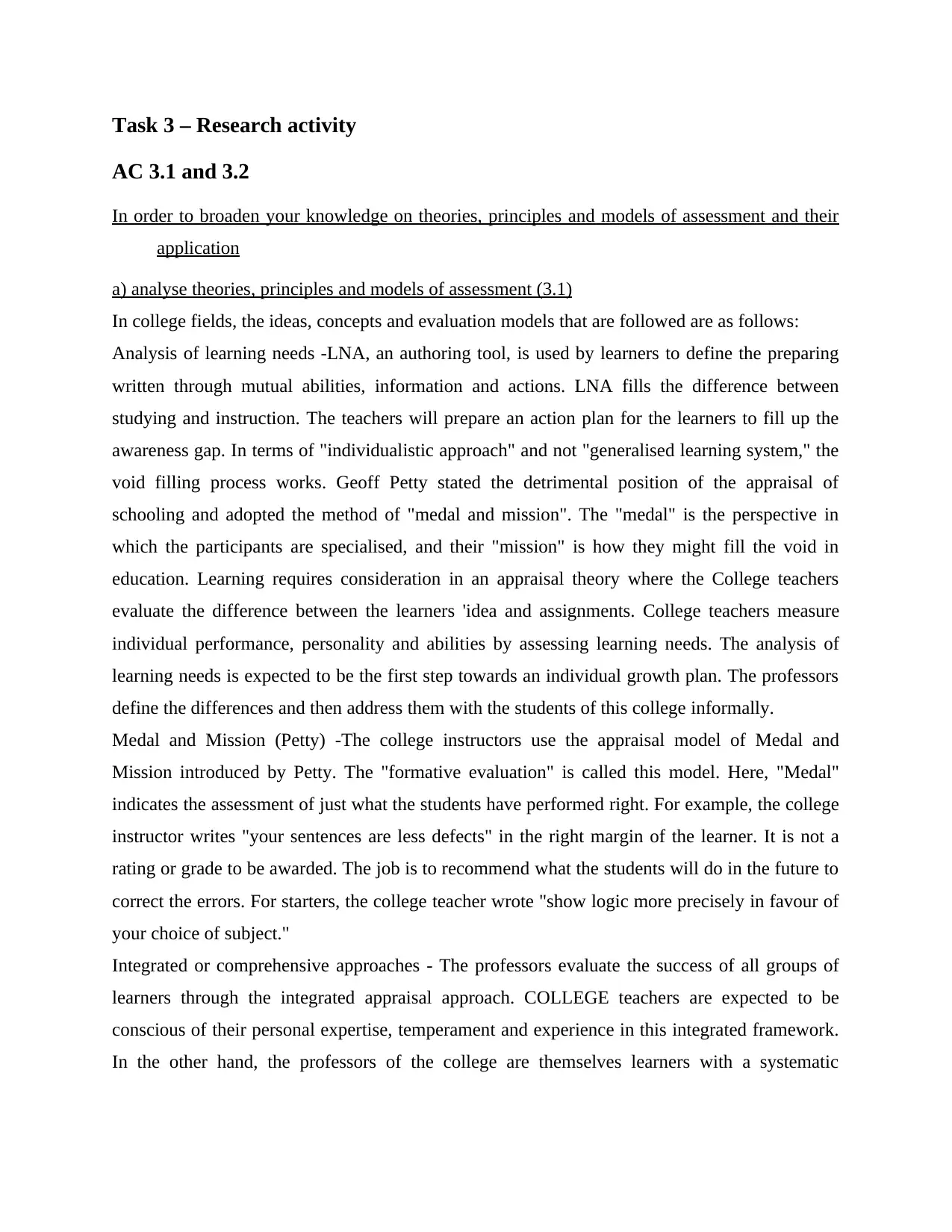
Task 3 – Research activity
AC 3.1 and 3.2
In order to broaden your knowledge on theories, principles and models of assessment and their
application
a) analyse theories, principles and models of assessment (3.1)
In college fields, the ideas, concepts and evaluation models that are followed are as follows:
Analysis of learning needs -LNA, an authoring tool, is used by learners to define the preparing
written through mutual abilities, information and actions. LNA fills the difference between
studying and instruction. The teachers will prepare an action plan for the learners to fill up the
awareness gap. In terms of "individualistic approach" and not "generalised learning system," the
void filling process works. Geoff Petty stated the detrimental position of the appraisal of
schooling and adopted the method of "medal and mission". The "medal" is the perspective in
which the participants are specialised, and their "mission" is how they might fill the void in
education. Learning requires consideration in an appraisal theory where the College teachers
evaluate the difference between the learners 'idea and assignments. College teachers measure
individual performance, personality and abilities by assessing learning needs. The analysis of
learning needs is expected to be the first step towards an individual growth plan. The professors
define the differences and then address them with the students of this college informally.
Medal and Mission (Petty) -The college instructors use the appraisal model of Medal and
Mission introduced by Petty. The "formative evaluation" is called this model. Here, "Medal"
indicates the assessment of just what the students have performed right. For example, the college
instructor writes "your sentences are less defects" in the right margin of the learner. It is not a
rating or grade to be awarded. The job is to recommend what the students will do in the future to
correct the errors. For starters, the college teacher wrote "show logic more precisely in favour of
your choice of subject."
Integrated or comprehensive approaches - The professors evaluate the success of all groups of
learners through the integrated appraisal approach. COLLEGE teachers are expected to be
conscious of their personal expertise, temperament and experience in this integrated framework.
In the other hand, the professors of the college are themselves learners with a systematic
AC 3.1 and 3.2
In order to broaden your knowledge on theories, principles and models of assessment and their
application
a) analyse theories, principles and models of assessment (3.1)
In college fields, the ideas, concepts and evaluation models that are followed are as follows:
Analysis of learning needs -LNA, an authoring tool, is used by learners to define the preparing
written through mutual abilities, information and actions. LNA fills the difference between
studying and instruction. The teachers will prepare an action plan for the learners to fill up the
awareness gap. In terms of "individualistic approach" and not "generalised learning system," the
void filling process works. Geoff Petty stated the detrimental position of the appraisal of
schooling and adopted the method of "medal and mission". The "medal" is the perspective in
which the participants are specialised, and their "mission" is how they might fill the void in
education. Learning requires consideration in an appraisal theory where the College teachers
evaluate the difference between the learners 'idea and assignments. College teachers measure
individual performance, personality and abilities by assessing learning needs. The analysis of
learning needs is expected to be the first step towards an individual growth plan. The professors
define the differences and then address them with the students of this college informally.
Medal and Mission (Petty) -The college instructors use the appraisal model of Medal and
Mission introduced by Petty. The "formative evaluation" is called this model. Here, "Medal"
indicates the assessment of just what the students have performed right. For example, the college
instructor writes "your sentences are less defects" in the right margin of the learner. It is not a
rating or grade to be awarded. The job is to recommend what the students will do in the future to
correct the errors. For starters, the college teacher wrote "show logic more precisely in favour of
your choice of subject."
Integrated or comprehensive approaches - The professors evaluate the success of all groups of
learners through the integrated appraisal approach. COLLEGE teachers are expected to be
conscious of their personal expertise, temperament and experience in this integrated framework.
In the other hand, the professors of the college are themselves learners with a systematic
⊘ This is a preview!⊘
Do you want full access?
Subscribe today to unlock all pages.

Trusted by 1+ million students worldwide
1 out of 19
Related Documents
Your All-in-One AI-Powered Toolkit for Academic Success.
+13062052269
info@desklib.com
Available 24*7 on WhatsApp / Email
![[object Object]](/_next/static/media/star-bottom.7253800d.svg)
Unlock your academic potential
Copyright © 2020–2025 A2Z Services. All Rights Reserved. Developed and managed by ZUCOL.

